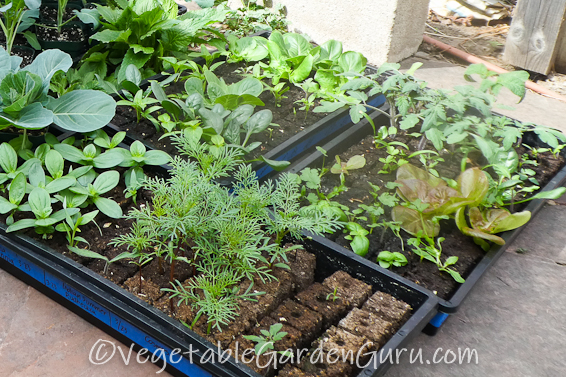- Home
- How to Start Seeds Indoors
- Soil Blocks
Using Soil Blocks for Starting Seeds Indoors
Soil blocks rock!
For decades, I started my seedlings in very sturdy, commercial-quality plastic seed trays, available through Gardener's Supply. These are the only seed-starting trays I've found for the consumer market that were durable enough to appease my love of quality, and for me to rationalize using plastic. But now...
 Sunflowers, Cosmos, Tomatoes, Spinach, Lettuce and More,
Sunflowers, Cosmos, Tomatoes, Spinach, Lettuce and More,All Started in Soil Blocks
I only use them when I fail to make enough soil blocks.
For starting seeds indoors, 90% of the time I now use a soil block maker, and create a bazillion little soil blocks that stand up by themselves with no pot at all, even when you water them! This is the absolute best system for starting seeds indoors because it is:
- sustainable indefinitely
- Earth-friendly
- cost-effective
- plastic-free
- much better for developing healthy root systems
- the method of choice now for many organic farmers
Making soil blocks is more labor-intensive up-front... but then what's wrong with that if it gives me something to do in January when I want to get my hands in the dirt, but it's still too early to actually start anything? Making soil blocks cures my winter gardening blues!
The Soil Block Maker
So what is a soil block maker and how does it work?
A soil block maker is a very cool metal form that has four or five (or even up to twenty, if you're a farmer) cube-shaped cells. You press the contraption down into a special recipe of sticky potting mix. Once you've packed the cells with the sticky potting mix, you lift it over to an empty tray and squeeze the plunger, which ejects perfect little 1 1/2" or 2" cubes.
Each cube has a small depression in the top for planting a seed, which you then cover with a bit more mix. Because of the specific potting mix used, the cubes stand up by themselves without containers of any kind, and don't crumble apart even when you water them!
The most obvious advantage to soil blocks is their sustainability. But they are also much better for seedling root growth. When the growing roots reach the edge of the block, they hit the air and just stop growing, instead of circling around.
This is known as "air pruning". If roots hit a hard physical limit like the side of a pot, they turn sideways and circle round and round, and never quite recover. The plant knows it's reached a hard limit, and it gets that stuck in its little head - and in its growth pattern - forever. Plants have their own intelligence, and if there is nowhere for the roots to expand, the plant will think it's going to die and switch over to flowering and making whatever few seeds it can before it dies.
I've seen people get really excited at Home Depot when they see a little tomato plant with flowers on it, snatching it up thinking "it's going to make tomatoes soon!". That's true. But like a half-grown kitten that has its own kittens before it's fully-grown itself, it will be stunted for life and never quite reach its full potential.
But with air pruning, as soon as you transplant your seedling out, the roots just start growing again, straight out and down as they would have if the seed had just been planted in the ground in the first place. The roots haven't given up, they've just stopped growing for a bit.
Making Soil Blocks Requires Special Potting Mix
|
Use the soil block potting mix recipe to make soil blocker mix. Peat moss was used in the original "Eliot Coleman" recipe (from his book The New Organic Grower), but peat is a non-renewable, unsustainable resource - at least in human timeframes - so for sustainability reasons I now use coconut coir (pron. "COY-er") instead. It's ground up coconut husks and is a byproduct of coconut processing. |
Soil Block Potting Mix: |
If you live in a state where pot is legal, the pot-growing supply stores are an affordable source for coir, perlite, soil minerals and other "potting" supplies. I don't partake myself, but I do buy some growing supplies there because they are a fraction of the cost of the same thing at my local Ace Hardware.
You're also going to need trays to set the soil blocks in. You can use a cafeteria tray, a "1020" seed flat (the kind without holes recommended), or even a piece of rigid plastic, like the lid to a storage box. I use extra-heavy duty 1020 trays (the 10"x20" seed flat trays that hold the seedlings that you buy from the nursery). You can purchase these extra-heavy duty, permanent ones at a pot-grower's supply store, or an even better option is the "Small Boot Tray" from Gardeners Supply.
Help share the skills and spread the joy
of organic, nutrient-dense vegetable gardening, and please...
~ Like us on Facebook ~
Thank you... and have fun in your garden!
Affiliate Disclaimer
This website contains affiliate links to a few quality products I can genuinely recommend. I am here to serve you, not to sell you, and I do not write reviews for income or recommend anything I would not use myself. If you make a purchase using an affiliate link here, I may earn a commission but this will not affect your price. My participation in these programs allows me to earn money that helps support this site. If you have comments, questions or concerns about the affiliate or advertising programs, please Contact Me.Contact Us Page



